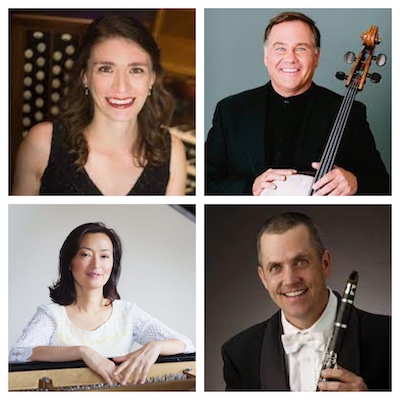by Jarrett Hoffman

•Today: organist Monica Csausz Berney at Trinity and a clarinet-cello-piano trio in Rocky River
•Announcements: Re:Sound Festival accepting proposals, Stroud Classical Guitar Competition applications, Heights Arts season details, and learning about CAC’s grantmaking process
•Almanac: Adolphe Sax, inventor of the saxophone and more
HAPPENING TODAY:
Organist Monica Csausz Berney kicks off the evening schedule with a 7:30 recital at Trinity Cathedral, co-sponsored by the Cleveland Chapter of the American Guild of Organists. As Daniel Hathaway wrote in a preview, “Berney will make use of both the Cathedral’s 1977 Flentrop organ and its 2022 Skinner / Aeolian-Skinner / Mueller instrument in a program largely devoted to transcriptions of works originally written for other musical media” — including works by J.S. Bach, Johannes Brahms, Nikolai Kapustin, Sigfrid Karg-Elert, and Pyotr Ilyich Tchaikovsky.
And at 7:30 at West Shore Unitarian Universalist Church, the Rocky River Chamber Music Society presents cellist Keith Robinson, pianist Hyunsoon Whang, and clarinetist Daniel McKelway in music by Samuel Barber, Sergei Prokofiev, and Johannes Brahms. The recital will also be streamed. Read Mike Telin’s interview with Robinson here.
A freewill offering will be taken up at both events. Program details can be found in our Concert Listings.
ANNOUNCEMENTS:
The Cleveland Uncommon Sound Project is now accepting proposals — both for performances and for sound art — for the 2024 Re:Sound New & Experimental Music Festival. The deadline is December 1. More info here.
Applications for the James Stroud Classical Guitar Competition will be accepted from January 1 through midnight Pacific Time on February 17. The competition is open to students ages 13-18 who are U.S. residents and are not enrolled in a university-level music degree program. Learn more here.
Heights Arts has announced its 2023-24 season, including the Close Encounters series (Sundays at 3 pm), the ARTbar series (Thursdays at 7 pm), and the free Gallery Concert series (Thursdays at 7 pm). Details here.
And Cuyahoga Arts & Culture will hold an Information Session and Q&A on Wednesday, November 8 from 4-5 pm on Zoom for those who would like to learn about the organization’s grantmaking process. Register here.
TODAY’S ALMANAC:
This date in music history has brought with it the deaths of German composer and organist Heinrich Schütz (1672 in Dresden), Russian composer Pyotr Ilyich Tchaikovsky (1893 in St. Petersburg), and French composer Edgar Varèse (1965 in New York), as well as the births of Belgian instrument inventor Adolphe Sax (1814 in Dinant) and American composer and conductor John Philip Sousa (1854 in the nation’s capital).

The saxophone is an entire family of nine instruments, ranging from subcontrabass up to sopranissimo — some of those invented by Sax, some designed but never built by him, and some developed by others in the years since then. The most common are the alto, tenor, baritone, and soprano, comprising the typical instrumentation for the saxophone quartet. To honor that other birthday boy, listen to Gregory Ridlington’s sax quartet arrangement of Sousa’s Stars and Stripes Forever here, played by members of “The President’s Own” Marine Band.
Hector Berlioz was a friend of Sax’s and an early supporter of the saxophone. In 1844, for a concert of his own music, Berlioz made an arrangement probably of his Chant sacré for a sextet of the inventor’s instruments, including saxophone. Click here to listen to the Saxback Ensemble play Guillaume Guillon’s arrangement of that work for an instrumentation with likely some similarity to the one heard in 1844: two clarinets (soprano and bass), three saxophones (alto, tenor, and baritone), and euphonium.
Saxophone fans can thank their lucky stars that the instrument even exists. As a 1972 article in Time Magazine read:
As a boy in early 19th century Belgium, Adolphe Sax was struck on the head by a brick. The accident-prone lad also swallowed a needle, fell down a flight of stairs, toppled onto a burning stove, and accidentally drank some sulfuric acid. When he grew up, he invented the saxophone.


